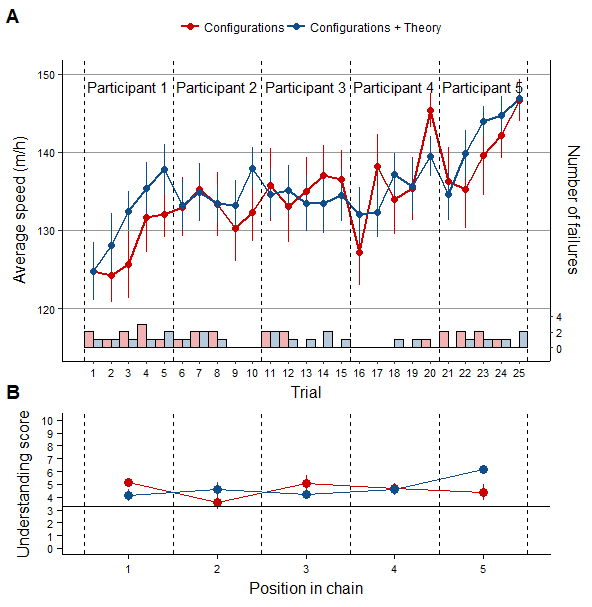We modern humans live in a world surrounded by ever evolving technology. Whether it’s the combustion engine or the modern computer, these technologies are ubiquitous and have radically altered the world we live in.
What’s no so obvious is how complex the technologies of traditional societies are too. Bow and arrows and clothing are just a couple of sophisticated technologies that pre-industrial humans created, and used to venture into new, challenging environments.
How is it that we humans have managed to produce such impressive technology, when our closest living primate relatives have produced nothing of the sort?
Many believe this comes down to our superior cognitive abilities. That is, our intelligence and our ability to reason.
However, some scientists argue that the inherent complexity of certain technologies make them very hard to understand. Instead, they argue that complex technologies result from many small improvements made over generations which are culturally transmitted– without people understanding how these technologies actually work.
To help settle the debate, Maxime Derex and his colleagues Jean-François Bonnefon, Robert Boyd and Alex Mesoudi conducted a rather ingenious experiment, involving a technology which changed the face of our planet: the wheel.
Note that at the time of writing this post, the paper is a preprint and yet to be peer-reviewed, and is therefore subject to further to scrutiny. Despite the amendments that may be made to the paper, the significance of this study should become apparent.
Spinning wheels
The experiment boiled down to getting participants to increase the speed of a wheel down a meter long, inclined track. The wheel had 4 radial spokes, and a single weight could be moved along each spoke.
Participants were organised into ‘chains’ of 5 individuals. Each participant had 5 trials to minimize the time it took for the wheel to reach the end of the track. All participants were provided with the last two choices and scores of the previous participant in their chain (except those who went first). 14 chains were run, with each containing different people.
In total, 140 people took part in the study (with two versions of the experiment conducted). Each person received money for participating in the experiments. The money they received ranged from €3 to €29, depending on their performance and that of their peers.
Derex and his colleagues provide sound reasons for choosing a wheel for their experiment on causal understanding. First, existing studies suggest Westerners generally have poor understanding of how wheels work, which means most participants didn’t know what was required of them (this is not meant to be insulting). Secondly, the speed of the wheel depends solely on the laws of physics, and not on irrelevant factors which could compromise the validity of their findings. And thirdly, the wheel systems doesn’t involve many dimensions, which made it well suited for hypothesis testing.
So what were the researchers actually evaluating? They were essentially testing whether wheel speeds would increase after several generations of trails, and if people’s understanding of the underlying physics would do too.
The wheel’s speed depends on just two variables: its moment of inertia (how mass is distributed around the axis), and its initial potential energy (the distance between the wheel centre of mass and the ground).
If the weights are located closer to the centre of the wheel, and if one of the weights at the top or to the right of wheel are further away from the axis before its descent, then the wheel will cover the track faster. Note that there’s a trade-off here between the two forces, and some experimentation is required to work out the optimal configuration.
The simplicity of the system meant the researchers could measure participants’ understanding of the wheel after they completed their trials. The research team evaluated their understanding by presenting them with a few options, and asking them to predict which wheels would cover the track faster.

So what did Derex and his team find having conducted the experiment?
After the 5 generations, the average wheel speed increased significantly. However, participants’ actual understanding of the physics did not.
The average wheel speed produced by the first participants on their last trial was 123.6 meters per hour, and their average understanding score was 4.60. After 5 generations, the average wheel speed increased to 145.7 meters per hour, while participants’ understanding didn’t significantly change.
With a maximum possible speed of 154 m/h, the team found remarkable improvements in just a few generations.
Stifling exploration
The authors were particularly interested in whether or not the sharing of lay theories to one and another would increase people’s understanding.
To further explore how individuals gain their understanding, Derex and his colleagues ran another version of the experiment.
The set up was largely the same, with 5 trials per participant and 14 chains. However, the difference was that participants could now also write their own theory about the wheel, and share this with the next participant in their chain.
All participants were provided with the previous participant’s theory, except those who were starting.
What did they find? The average wheel speed increased at a similar rate to the first experiment, and the participants’ understanding also barely changed across the generations (see the graph below).
Counter-intuitively, the authors also found that the sharing of theories had a negative effect on participant’s actual understanding of the underlying physics.

Although little differences were observed between the experimental conditions overall, further digging found “striking” differences in participant’s exploration and independent learning.
The researchers found that if a participant had received a theory about either inertia or potential energy, then their configurations would be constrained to one of these forces. In other words, inheriting an inertia theory increased their understanding of this dynamic, but reduced participant’s understanding of energy (and vice versa).
The main explanation presented is that receiving a theory mostly constrained participants’ focus, and blinded them to the dynamics beyond the theory they received.
Derex and his colleagues argue that these results support the theory that small improvements occur over generations via cultural transmission, in the absence of people’s actual understanding of the technology.
As stated by the authors:
These results indicate that highly optimized technologies do not necessarily result from evolved reasoning abilities but instead can emerge from the blind accumulation of many small improvements made across generations linked by cultural transmission, and demand a focus on the cultural dynamics underlying technological change as well as individual cognition.
Implications
With the paper yet to be peer reviewed, it does seem a bit premature drawing lessons from the study at this stage. However, a wealth of research demonstrates the role of cultural evolution in driving technological advancement, which means we can have some confidence in the research findings.
The authors also note that these experiment were conducted on ‘WEIRD’ people. That is, those who are Western, educated, industrialised, rich and democratic. Further experiments would need to be conducted cross-culturally to confirm whether or not this finding is universal.
These points aside, one key take away I took from these experiments are the roles groups and demographics play in fostering technological advancements, rather than the contributions of individuals.
In business and society more broadly, a widespread belief is that the most significant innovations come from geniuses and their novel ideas. However, such experimental findings from the field of cultural evolution reveal how overly simplistic these beliefs are; these beliefs ignore the wider environmental factors and culturally acquired knowledge that facilitate novel insights in the first place.
Another potential lesson concerns exploration and independent learning. If it is the case that receiving incomplete theories can compromise people’s understanding of technology, then this has implications for research and development professionals (or anyone fostering innovation for that matter). Working around this effect and encouraging independent learning may lead to insights which may have otherwise been missed.
Ultimately, such findings illustrate the importance of experimentation in driving technological advancements. Whether one is trying to improve a process or create new products, continuous small-scale experimentation may lead to new technologies being developed- although you may not understand how they actually work.
Written by Max Beilby for Darwinian Business
Note: Derex et al’s paper has since been published in the journal Nature Human Behaviour (1st April 2019)

(Noth sure this got through first time)
Beautifully clear exposition of a highly significant experiment and paper. It does strike me however that Derex et al. are so gobsmacked by the implications of the outcome, which are pretty alien to the consensual focus of Cultural Evolution Studies, that they are determined to get the notion of cultural transmission in somewhere. I would dispense with the term entirely for the moment and say, in Natalie Gontier’s phrase, you have to tell me what is being transmitted, where it is being transmitted, and how it is being transmitted. Whatever it is in the case of the second experiment, the difference between the two demonstrates, as most people agree, that it has little effect.
Chris Buckley’s and Eric Boudot’s The Evolution of an Ancient Culture (Buckley, 2017) demonstrates exactly the same thing, but in the context of the historical evolution of South and East Asian looms, and it is salient that two such papers, one on a stripped down and elegant experiment, the other on a richly complex evolved technology, converge in such a way in their conclusions. Buckley does have something to say about cultural transmission, in the very specific sense of a kinetic chain which goes from durable registrations in the brain, via muscle contraction (Richard Dawkins’ characterisation of behaviour) into dynamic action upon things-in-the world; in this case the function of song and ritual in setting up a loom. Ultimately, both Derex et al. and Buckley et al. ‘s work suggests that the categories of both “social learning” and “cultural transmission” need rigorous redefinition.
LikeLiked by 1 person